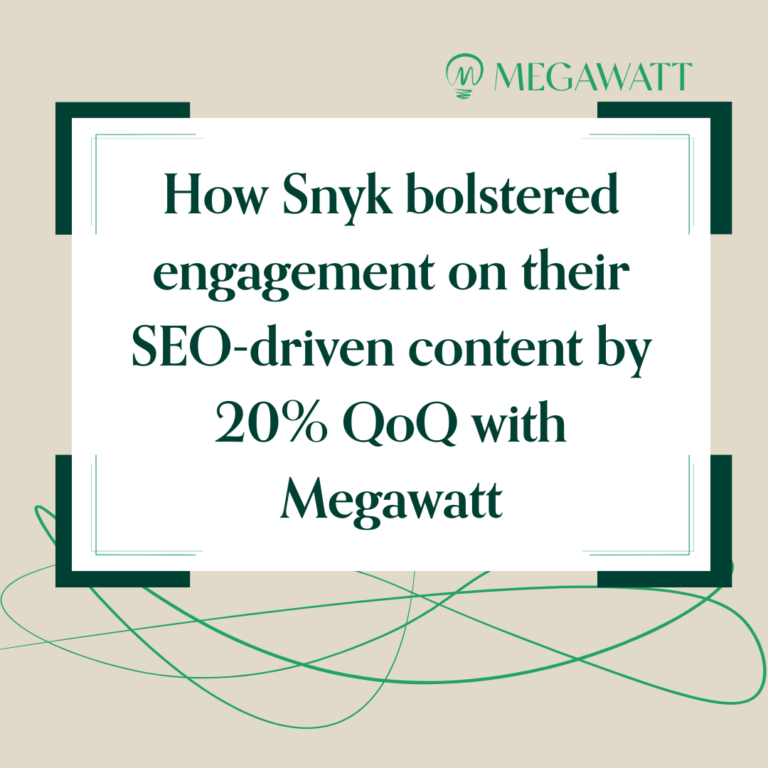How to Embed SMEs into Your B2B Content Production Process
Working with subject matter experts — and we say this with love — can be challenging. At some point or another, all B2B content writers have received feedback from an SME that looks something like:
“We don’t offer this, so we shouldn’t talk about it.”
“It needs more detail.” (But doesn’t provide said details.)
“Add links to our product here…here, here, here, and here.”
While content marketers might be charged with producing so many pieces of content per month or improving SEO rankings, SMEs from other departments in the organization are not. They’ve cultivated a completely different skill set and have other important responsibilities within your organization, which can cause friction when collaborating on content.
So why do we bother?
The benefits of tapping into SME expertise
SMEs are key to publishing high-quality content that is useful to your target audience.
Quality is paramount in B2B marketing, as nearly 100% of B2B buyers prefer self-serve sales processes. Your prospects would rather research and compare solutions through content than have a conversation with a sales representative, and it’s on content marketers to deliver that experience.
Not only are your prospects looking for this content, but Google is getting better at ranking resources that more precisely meet their needs. It does this through keyword matching and other ranking factors in its algorithm, but there’s also a human element to SEO. Google uses E-E-A-T, short for Experience, Expertise, Authoritativeness, and Trustworthiness, to evaluate the quality and value of a piece of content.
For these reasons, 83% of marketers agree; it’s more effective to create fewer pieces of high-quality content than to publish mediocre content often. In technical industries, that bar is exceptionally high.
Raising the bar for technical B2B content
To meet the needs of a highly technical audience, content marketers — who are likely experts in marketing strategy, SEO, and storytelling — may turn to internal SMEs, like software developers or cybersecurity specialists. These SMEs bring first-hand experience and deep industry expertise to the company’s content table, which is vital to checking each of the E-E-A-T boxes.
However, partnerships between these two roles can sometimes be bumpy. Luckily, there are many things you can do to set the collaboration up for success.
Understand where your SME is coming from
Before diving in, let’s take a moment to understand where SMEs are coming from. You’ll likely approach content creation differently, prioritize different things, and have different writing styles. Consider their perspective to minimize friction.
Things to remember:
- Their version of “the basics” may look very different from a marketer’s. You probably have a solid understanding of your organization’s offering and target audience, but SMEs have such depth of knowledge that it isn’t unusual for them to dive straight into the deep end, unintentionally leaving the writer behind.
- SMEs often aren’t familiar with content marketing strategy. They may not be aware of your priorities or the general best practices that go into every piece of content (e.g., why we shouldn’t use a statistic from a blog published in 2015 on ILuv2Code.com).
- They live and breathe the product daily, so they may approach content creation with a product-heavy lens, regardless of where the piece falls in your marketing funnel. This could look like stuffing each blog with sales messaging or only approving topics that closely align with the company’s offering.
- They’re also very, very busy. More often than not, content creation isn’t in their job description, so understandably, they’d rather focus on tasks that will come up in their quarterly review.
- Sometimes, writing isn’t their strongest skill set, so their feedback may or may not be all that helpful. (No shade, we wouldn’t want them to judge our coding skills either!)
Sign up for Dear Wattson, our weekly newsletter, where all content conundrums are answered!
Tips for a successful partnership between writer and SME
There are many ways to structure your partnership with an internal SME. They may come to the table knowing exactly what they want to say, ready to share a completed outline or even a first draft. However, for the reasons described above, they’ll likely prefer a more hands-off approach.
The following tips guide this sort of engagement: the content writer does most of the research, outlining, and drafting, while the SME shares their knowledge and provides technical reviews.
#1 Demonstrate what’s in it for them
Leading with the value proposition is marketing 101. It’s important to ensure the SME understands how participating in the organization’s content strategy will benefit them and the business before giving them homework.
We know B2B buyers are vetting companies through the content they produce. By participating in content creation, your SME will make a real impact on business growth. The pieces they collaborate on might be used to generate leads, move those leads through the funnel, and close sales, all of which are great ways to stand out to leadership.
Content production is also a great way to build their own personal brand. This can help them land speaking gigs, open up career opportunities, and establish themselves as an industry expert.
#2 Explain the “why” behind this asset
From our perspective as marketers, there’s a whole lot of “why” behind a single piece of content. We’re thinking about high-level content strategy, best practices for different funnel stages, our target audience, and how the piece will be used.
But here’s the thing…an SME only needs to know enough to be an effective partner.
They don’t need to know the character limit for meta titles or how Google Analytics works. (Unless they want to!) You only have so much of their time and focus. Be smart with how you use it.
To set them up for success, we recommend sharing these things:
- Target audience
- Purpose of the piece
- Specific topic or angle
#3 Agree on a workflow
Make sure to align with your SME on what the content creation process will look like. This could vary from one internal SME to the next and will certainly differ from your own writing process.
For example, you might want to kick things off with an interview, then get their feedback on your outline, and later, have them drop comments and suggestions throughout the full draft. If they know exactly what they’re committing to, they can more effectively plan for these additional tasks.
Important considerations:
- Determine how familiar they are with content marketing.
- Give them a quick overview of what you’ll need from them.
- Discuss your ideal timeline and any hard due dates.
- Share how you like to receive feedback (i.e., in-line suggestions, comments, zoom calls).
- Ask how they prefer to deliver their feedback.
#4 Negotiate around capacity and scheduling
You might go into your first meeting ready to pitch a six-blog series on a hot topic in the industry, but your SME may only have time to help with two. Work together to determine priorities and pare the project down to something more manageable.
In the last section, we described a workflow that involved an SME interview, outline review, and first draft review. Find out how much time they’ll need for each stage, and plan to send reminders a day or two early or offer to preemptively put time on their calendar to review feedback (you can always cancel it later.)
Be sure to let them know if this content is part of a larger marketing push. If the blog is being used to promote a webinar or is part of a product launch, you likely have a hard deadline. Sometimes, a little extra urgency greases the review wheels.
#5 Make specific, detailed requests
“Hey, take a look at this when you have a chance.”
We’ve all used messages like this. We want to respect our colleague’s time and expertise, so going easy on the ask can be tempting. But they can’t meet a deadline or provide effective feedback if you don’t clue them in on the details.
Make sure they know what you need when you need it, and exactly what type of support you’re looking for, whether an informational interview before you outline or an expert review of the final draft. Unhelpful feedback wastes everyone’s time, so help your SME help you!
Below are two sample review requests:
Technical SME review:
This ebook is in the first draft stage. It’ll be used as a lead magnet to capture prospects’ emails.
In this first draft, we’re looking for a technical review to ensure correct terminology usage, add illustrative examples, or include more specific details. Most importantly, please watch for any gaps or errors that would cause a software developer to lose trust/interest.
Will you have time to review by DATE?
Product Manager review:
This blog will be used to kick off an ongoing thought leadership series. In addition to being educational, it will also serve as an introduction to the company and our voice.
It’s in the outline phase, so we’re looking for a high-level review. We want to ensure we align with our branding, but please remember that this is not a product-specific piece.
I’ll need feedback by DATE, if we want to keep our original timeline. If that won’t work, please let me know!
As you move through the process, you can also direct reviewers to our Reviewer Matrix whenever they need a quick refresher.
![]()
#6 Ask great questions
“Can you tell me about flux capacitors?”
vs.
“Can you tell me about common errors people make when installing flux capacitors into used vehicles and how to avoid them?”
There’s a big difference between these two questions, right? You might be working with an expert who’s a fount of information and needs little prompting. (Lucky!) But most often, SMEs don’t know what kinds of detail would be helpful or how technical they should go. It’s our job to guide them.
The most effective way of doing this is by asking thought-provoking questions. This is as true during an informational interview, as it is when you’re confused about feedback they’ve left in the document. Don’t be surprised if this requires multiple questions, pushing them to approach the issue from various angles.
#7 Don’t waste their time
Do as much legwork as possible before asking an SME to dive in. The more prepared you are, the faster you’ll get what you need, and the quicker you can let them get back to their day. By making the process easy, you’ll increase the chances they’ll be willing to collaborate again.
That means researching before your initial interview and possibly creating a rough outline. Have an idea of where your knowledge gaps are or what gap you’ve identified in the content that’s already available.
If they’ve left you confusing feedback or you’re not sure their suggestion suits this specific piece, don’t waste too much time going back and forth in the comments. If it hasn’t been resolved after they answer your initial request for clarification, go straight to Slack or a phone call (based on the preferences you discussed earlier). And when you’ve identified an issue, prepare potential solutions before bringing it to the SMEs attention.
#8 Follow up and show your appreciation
Your SME has gone out of their way to make a valuable contribution to the business’s content strategy, and they deserve a thank you. It might also be a good idea to give them a Slack shout-out to make sure leadership knows about the extra effort they’ve put in.
After the post goes live, give it the best chance for success with an excellent distribution strategy. There’s nothing more discouraging than dedicating time and energy to a blog that immediately fades into obscurity.
The results of marketing efforts roll in over weeks or months, but make sure to share any positive traction the piece generates. Tell the SME if their blog ranks high on Google or gets tons of social media shares. And hey, another public shoutout detailing that success might be in order.
Facilitating smooth collaboration with SMEs is worth your time
You’ll notice that much of the advice above gravitates toward one thing: making this process easy for the SME.
Doing research, prepping questions, carefully managing timelines, and sending reminders take extra time and effort on the content marketer’s part. Still, the result is very much worth your while. SME support enables you to produce excellent content that will boost viewership and generate leads, hitting your KPIs.
Is your company heavy on technical SMEs and short on content writers? If so, we’d love to supplement your content marketing team. Contact us today to learn more about our content services.






